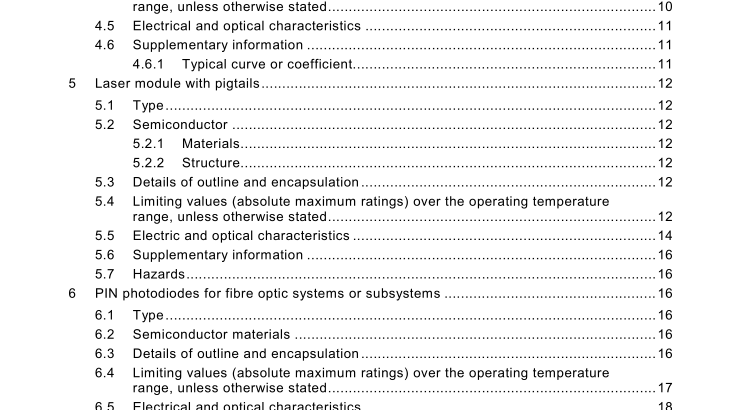IEC 62007-1:2008 pdf download – Semiconductor optoelectronic devices for fibre optic system applications – Part 1: Specification template for essential ratings and characteristics
1 scope and object
This part of lEC 62007 is a specification template for essential ratings and characteristics ofthe following categories of semiconductor optoelectronic devices to be used in the field of fibreoptic systems and subsystems:
– semiconductor photoemitters;
– semiconductor photoelectric detectors;
– monolithic or hybrid integrated optoelectronic devices and their modules.
The object of this performance specification template is to provide a frame for the preparationof detail specifications for the essential ratings and characteristics.
Detail specification writers may add specification parameters and/or groups of specificationparameters for particular applications.However,detail specification writers may not removespecification parameters specified in this standard.
2Normative references
The following referenced documents are indispensable for the application of this document.Fordated references,only the edition cited applies. For undated references, the latest edition ofthe referenced document (including any amendments) applies.
IEC 60825(all parts),Safety of laser products
IEC 60747-5-1,Discrete semiconductor devices and integrated circuits – Part 5-1:Optoelectronic devices – General
3Terms, definitions and abbreviations
For the purposes of this document, the following terms, definitions and abbreviations apply, aswell as terms and definitions concerning physical concepts, types of devices, general terms,and ratings and characteristics given in Ec 60747-5-1.
3.1Terms and definitions
3.1.1
PIN photodiode
photodiode with a large intrinsic region sandwiched between p- and n-doped semiconductingregions used for the detection of optical radiation
NOTE Adapted from IEV 731-06-29,specialized
3.1 .2
avalanche photodiode
APD
photodiode operating with a bias voltage such that the primary photocurrent undergoes amplification by cumulative multiplication of charge carriers.
NOTE Adapted from IEV 731 -06-30, specialized.
3.1 .3
relative intensity noise
RIN quotient of the radiant power mean square fluctuations <
3.1 .4
spectral shift
Δ λ c
deviation of the peak-emission wavelength at a particular case temperature or a particular forward current from its value at a specified reference case temperature or a specified reference forward current, respectively
NOTE The specific reference temperature is usually 25 °C.
3.1 .5
input reflection coefficient
s 1 1
quotient of the high frequency reflected voltage to the high frequency incident voltage
3.1.6
tracking error
E tr
deviation of the radiant power at a particular case temperature from its value at a specified reference case temperature
NOTE 1 The specific reference temperature is usually 25 °C.
NOTE 2 Specifications usually refer to the maximum deviation (absolute value) in two specified temperature ranges below and above the specified reference case temperature.
NOTE 3 The tracking error is usually expressed as a percentage of the radiant power at the reference case temperature.
3.1 .7
(diode) responsivity R D , R (of a photodiode)
quotient of the photocurrent I p by the radiant power Φ e at the optical port of the photodiode
NOTE 1 If no ambiguity is likely to occur, the shorter term and letter symbol may be used.
NOTE 2 “Photodiode” means a complete device such as:
– chip itself;
– packaged component with window or pigtail.
4 LEDs for fibre optic systems or subsystems
4.1 Type
Ambient-rated or case-rated LED with or without optical fibre pigtail for fibre optic systems or subsystems.
4.2 Semiconductor materials
GaAs, GaAlAs, InGaAs, InP, etc.
4.3 Details of outline and encapsulation
4.3.1 IEC and/or national reference number of outline drawing.
4.3.2 Method of encapsulation: glass/metal/plastic/other.
4.3.3 Terminal identification and indication of any electrical connection between a terminal and the case.
4.3.4 Characteristics of the optical port: relative orientation to mechanical axis, relative position to mechanical axis, area, numerical aperture.
4.3.5 For devices with pigtail: information on the pigtail fibre, kind of protection, connector,length.
